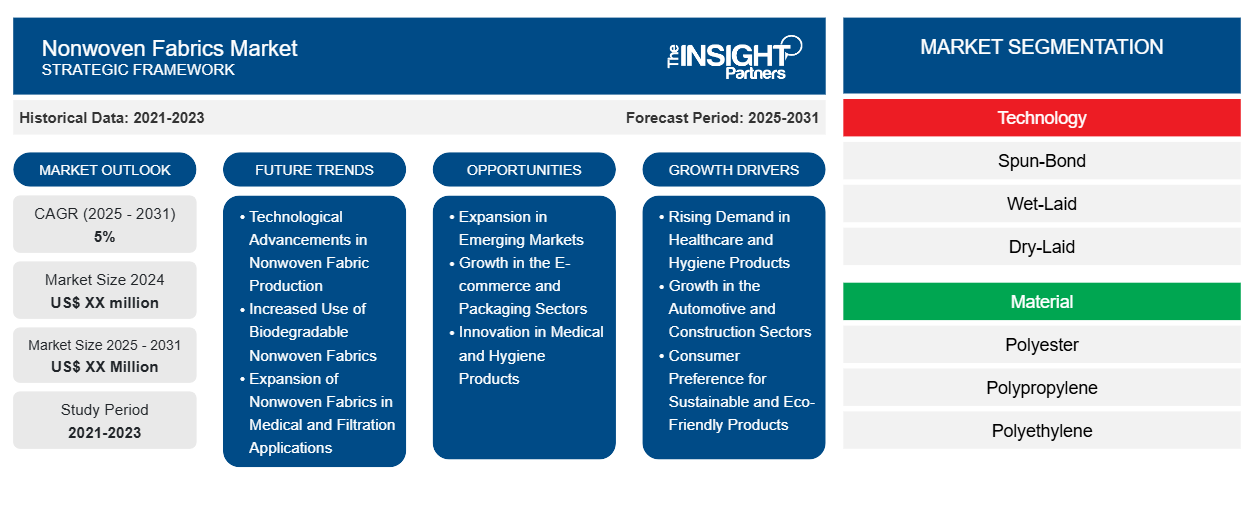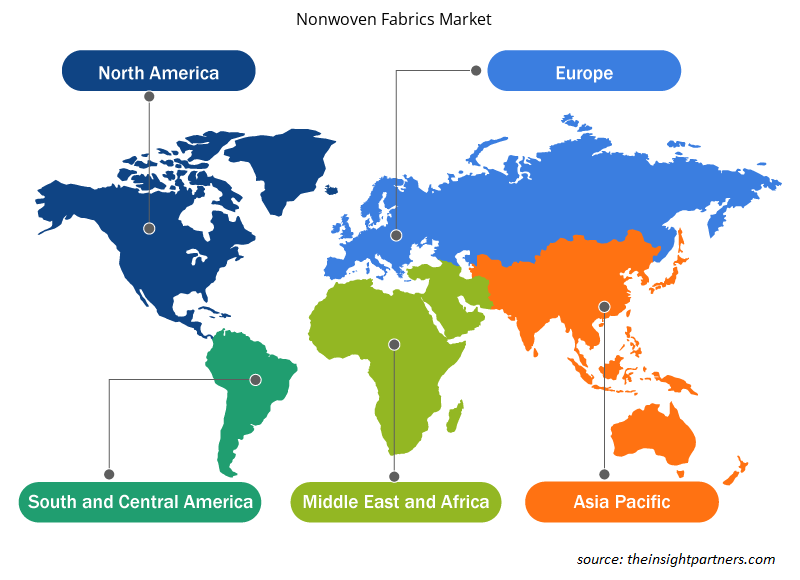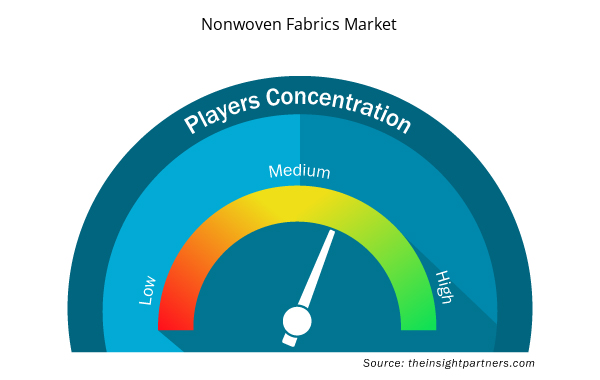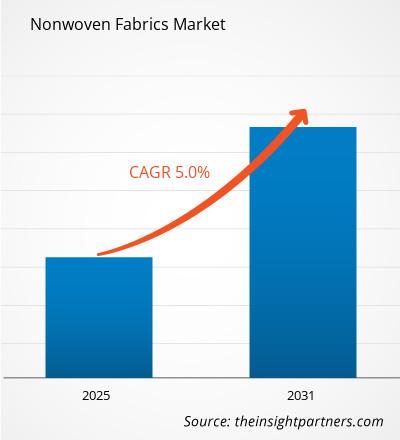The Nonwoven Fabrics Market is expected to register a CAGR of 5% from 2025 to 2031, with a market size expanding from US$ XX million in 2024 to US$ XX Million by 2031.
Nonwoven Fabrics Market Size and Forecasts (2021 - 2031), Global and Regional Growth Opportunity Analysis, Technology (Spun-Bond, Wet-Laid, Dry-Laid, and Other Technologies), Material (Polyester, Polypropylene, Polyethylene, Rayon, and Other Materials), End-User Industry (Construction, Textile, Healthcare, Automotive, and Other End-User Industries), and Geography (North America, Europe, Asia Pacific, Middle East and Africa, and South and Central America). Non-woven fabrics are a type of textile material that differ from traditional woven or knitted fabrics. They are manufactured by bonding or entangling fibers or filaments rather than waving or knitting them. Non-woven fabrics can be made up of natural fibers or synthetic fibers or a combination.
Purpose of the Report
The report Nonwoven Fabrics Market by The Insight Partners aims to describe the present landscape and future growth, top driving factors, challenges, and opportunities. This will provide insights to various business stakeholders, such as:
- Technology Providers/Manufacturers: To understand the evolving market dynamics and know the potential growth opportunities, enabling them to make informed strategic decisions.
- Investors: To conduct a comprehensive trend analysis regarding the market growth rate, market financial projections, and opportunities that exist across the value chain.
- Regulatory bodies: To regulate policies and police activities in the market with the aim of minimizing abuse, preserving investor trust and confidence, and upholding the integrity and stability of the market.
Nonwoven Fabrics Market Segmentation
Technology
- Spun-Bond
- Wet-Laid
- Dry-Laid
- Other Technologies
Material
- Polyester
- Polypropylene
- Polyethylene
- Rayon
- Other Materials
Customize This Report To Suit Your Requirement
You will get customization on any report - free of charge - including parts of this report, or country-level analysis, Excel Data pack, as well as avail great offers and discounts for start-ups & universities
Nonwoven Fabrics Market: Strategic Insights

- Get Top Key Market Trends of this report.This FREE sample will include data analysis, ranging from market trends to estimates and forecasts.
Nonwoven Fabrics Market Growth Drivers
- Rising Demand in Healthcare and Hygiene Products: The healthcare and hygiene sectors are major drivers of growth for the nonwoven fabrics market. Nonwoven fabrics are commonly used in products like surgical masks, gowns, diapers, sanitary napkins, and wound care products. With the increasing global awareness of hygiene and the surge in demand for personal protective equipment (PPE) due to the COVID-19 pandemic, the market for nonwoven fabrics in healthcare applications has expanded significantly. As the healthcare industry continues to grow and evolve, so will the demand for nonwoven fabrics.
- Growth in the Automotive and Construction Sectors: The automotive and construction industries are key sectors contributing to the demand for nonwoven fabrics. In the automotive industry, nonwoven fabrics are used in a variety of applications, including car upholstery, insulation, filters, and soundproofing. Similarly, in construction, nonwoven fabrics are used for geotextiles, roofing materials, and insulation. With urbanization, infrastructure development, and increasing automotive production, these industries continue to drive the demand for nonwoven fabrics.
- Consumer Preference for Sustainable and Eco-Friendly Products: There is a growing shift toward sustainability and eco-friendly products, which is boosting the demand for nonwoven fabrics made from natural and biodegradable materials. As more consumers and industries prioritize environmental responsibility, nonwoven fabrics, particularly those made from sustainable fibers like bamboo, cotton, and recycled PET, are gaining traction. The focus on reducing waste and embracing recyclable materials in packaging, clothing, and other consumer goods is driving this demand.
Nonwoven Fabrics Market Future Trends
- Technological Advancements in Nonwoven Fabric Production: Significant technological innovations are enhancing the production of nonwoven fabrics, leading to improved performance and efficiency. New manufacturing techniques such as spunbond, meltblown, and needle-punching have resulted in fabrics with better strength, durability, and water resistance. These advancements are expanding the potential applications of nonwoven fabrics, making them more attractive to various industries such as automotive, hygiene, and construction.
- Increased Use of Biodegradable Nonwoven Fabrics: With environmental concerns on the rise, there has been a noticeable trend towards the production and use of biodegradable nonwoven fabrics. These fabrics are being made from natural fibers like jute, hemp, and cotton or biopolymers, offering an environmentally friendly alternative to synthetic nonwoven materials. The shift towards sustainability in the production of nonwoven fabrics is becoming more prevalent, aligning with global efforts to reduce plastic waste and carbon footprints.
- Expansion of Nonwoven Fabrics in Medical and Filtration Applications: The demand for nonwoven fabrics in medical applications, including surgical masks, wound care products, and medical gowns, has surged, particularly in response to the COVID-19 pandemic. Additionally, nonwoven fabrics are increasingly used in air and water filtration products due to their high filtration efficiency. The healthcare sector's growing reliance on nonwoven fabrics for hygiene and protective products, as well as the rise in environmental concerns driving the need for better filtration solutions, is fueling this trend.
Nonwoven Fabrics Market Opportunities
- Expansion in Emerging Markets: Emerging economies, particularly in Asia-Pacific, Latin America, and Africa, present significant growth opportunities for nonwoven fabric manufacturers. As these regions experience industrialization, urbanization, and rising disposable incomes, the demand for nonwoven fabrics in sectors such as healthcare, hygiene, automotive, and construction is expected to increase. Manufacturers can capitalize on the growing middle class and the increasing need for modern infrastructure and consumer goods in these regions.
- Growth in the E-commerce and Packaging Sectors: With the rapid growth of e-commerce, there is an increasing demand for sustainable and protective packaging materials. Nonwoven fabrics, due to their lightweight, durability, and eco-friendly characteristics, present a strong opportunity for use in packaging applications. Companies focused on developing innovative packaging solutions using nonwoven materials can tap into the expanding e-commerce and retail markets that are shifting toward sustainable packaging alternatives.
- Innovation in Medical and Hygiene Products: The medical and hygiene industries present lucrative opportunities for nonwoven fabric manufacturers. The growing global healthcare needs, particularly in response to health crises like pandemics, are driving the demand for nonwoven fabrics in medical disposables, PPE, and hygiene products. Innovations in medical nonwoven fabrics, such as antimicrobial properties and enhanced fluid barrier capabilities, offer further potential for growth. Additionally, the ongoing focus on hygiene and sanitary products globally presents a continuous demand for advanced nonwoven materials in diapers, feminine hygiene products, and adult incontinence products.
Nonwoven Fabrics Market Regional Insights
The regional trends and factors influencing the Nonwoven Fabrics Market throughout the forecast period have been thoroughly explained by the analysts at Insight Partners. This section also discusses Nonwoven Fabrics Market segments and geography across North America, Europe, Asia Pacific, Middle East and Africa, and South and Central America.

- Get the Regional Specific Data for Nonwoven Fabrics Market
Nonwoven Fabrics Market Report Scope
| Report Attribute | Details |
|---|---|
| Market size in 2024 | US$ XX million |
| Market Size by 2031 | US$ XX Million |
| Global CAGR (2025 - 2031) | 5% |
| Historical Data | 2021-2023 |
| Forecast period | 2025-2031 |
| Segments Covered |
By Technology
|
| Regions and Countries Covered | North America
|
| Market leaders and key company profiles |
Nonwoven Fabrics Market Players Density: Understanding Its Impact on Business Dynamics
The Nonwoven Fabrics Market market is growing rapidly, driven by increasing end-user demand due to factors such as evolving consumer preferences, technological advancements, and greater awareness of the product's benefits. As demand rises, businesses are expanding their offerings, innovating to meet consumer needs, and capitalizing on emerging trends, which further fuels market growth.
Market players density refers to the distribution of firms or companies operating within a particular market or industry. It indicates how many competitors (market players) are present in a given market space relative to its size or total market value.
Major Companies operating in the Nonwoven Fabrics Market are:
- Ahlstrom Munksjo
- Berry Global Inc.
- Kimberly Clark
- Glatfelter
- Dupont Toray Industries
Disclaimer: The companies listed above are not ranked in any particular order.

- Get the Nonwoven Fabrics Market top key players overview
Key Selling Points
- Comprehensive Coverage: The report comprehensively covers the analysis of products, services, types, and end users of the Nonwoven Fabrics Market, providing a holistic landscape.
- Expert Analysis: The report is compiled based on the in-depth understanding of industry experts and analysts.
- Up-to-date Information: The report assures business relevance due to its coverage of recent information and data trends.
- Customization Options: This report can be customized to cater to specific client requirements and suit the business strategies aptly.
The research report on the Nonwoven Fabrics Market can, therefore, help spearhead the trail of decoding and understanding the industry scenario and growth prospects. Although there can be a few valid concerns, the overall benefits of this report tend to outweigh the disadvantages.
- Historical Analysis (2 Years), Base Year, Forecast (7 Years) with CAGR
- PEST and SWOT Analysis
- Market Size Value / Volume - Global, Regional, Country
- Industry and Competitive Landscape
- Excel Dataset


- Queue Management System Market
- Photo Printing Market
- Hydrocephalus Shunts Market
- Emergency Department Information System (EDIS) Market
- Fish Protein Hydrolysate Market
- Medical Enzyme Technology Market
- Green Hydrogen Market
- Authentication and Brand Protection Market
- Medical Devices Market
- Travel Vaccines Market

Report Coverage
Revenue forecast, Company Analysis, Industry landscape, Growth factors, and Trends

Segment Covered
This text is related
to segments covered.

Regional Scope
North America, Europe, Asia Pacific, Middle East & Africa, South & Central America

Country Scope
This text is related
to country scope.
Frequently Asked Questions
Growing demand for eco-friendly products is an emerging trend in the market.
The spun-bond technology segment accounted for the largest market share in 2023
The North America market is expected to account for the highest CAGR during the forecast period, owing to the growing automotive industry in the region.
Growing demand for hygiene products is a key driver in the market.
Ahlstrom Munksjo, Berry Global Inc., Kimberly Clark, Glatfelter, Dupont, Toray Industries, Lydall Inc., Fitesa, Suominen Corporation, Johns Manville, TWE Group, Fiberweb (India) Ltd., First Quality Enterprises, Inc., and Asahi Kasei Corporation are some of the key players in the market.
The Nonwoven Fabrics Market is estimated to witness a CAGR of 5% from 2023 to 2031
Trends and growth analysis reports related to Chemicals and Materials : READ MORE..
The List of Companies

 Get Free Sample For
Get Free Sample For